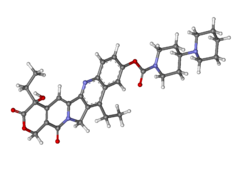Irinotecan
 | |
 | |
| Names | |
|---|---|
| Trade names | Camptosar, Campto, Onivyde, others |
| |
| Clinical data | |
| Main uses | Colon cancer, small cell lung cancer[1] |
| Side effects | Diarrhea, vomiting, bone marrow suppression, hair loss, shortness of breath, fever[1] |
| Pregnancy category |
|
| Routes of use | Intravenous |
| Defined daily dose | not established[2] |
| External links | |
| AHFS/Drugs.com | Monograph |
| MedlinePlus | a608043 |
| Legal | |
| Legal status | |
| Pharmacokinetics | |
| Bioavailability | NA |
| Metabolism | Liver glucuronidation |
| Elimination half-life | 6 to 12 hours |
| Excretion | Biliary and kidney |
| Chemical and physical data | |
| Formula | C33H38N4O6 |
| Molar mass | 586.678 g/mol (irinotecan) 623.139 g/mol (irinotecan hydrochloride) 677.185 g/mol (irinotecan hydrochloride trihydrate) g·mol−1 |
| 3D model (JSmol) | |
| |
| |
Irinotecan, sold under the brand name Camptosar among others, is a medication used to treat colon cancer, and small cell lung cancer.[1] For colon cancer it is used either alone or with fluorouracil.[1] For small cell lung cancer it is used with cisplatin.[1] It is given by slow injection into a vein.[1]
Common side effects include diarrhea, vomiting, bone marrow suppression, hair loss, shortness of breath, and fever.[1] Other severe side effects include blood clots, colon inflammation, and allergic reactions.[1] Those with two copies of the UGT1A1*28 gene variant are at higher risk for side effects.[1] Use during pregnancy can result in harm to the baby.[1] Irinotecan is in topoisomerase inhibitor family of medication.[4] It works by blocking topoisomerase 1 which results in DNA damage and cell death.[1]
Irinotecan was approved for medical use in the United States in 1996.[1] It is on the World Health Organization's List of Essential Medicines.[5] In the United Kingdom it is available as a generic medication and costs the NHS about £114 per 100 mg.[4] It is made from the natural compound camptothecin which is found in the Chinese ornamental tree Camptotheca acuminata.[1][6]
Medical uses
Its main use is in colon cancer, in particular, in combination with other chemotherapy agents.[7] This includes the regimen FOLFIRI, which consists of infusional 5-fluorouracil, leucovorin, and irinotecan. The regimen XELIRI consists of capecitabine and irinotecan.[8][9]
It may also be used together with fluorouracil and folinic acid for pancreatic cancer following failure of initial treatment.[10]
Dosage
The defined daily dose is not established[2]
Side effects
The most significant adverse effects of irinotecan include diarrhea, nausea and vomiting, neutropenia and fever, infections of blood or lungs (sepsis, pneumonia), shock, dehydration, kidney failure and thrombocytopenia (low levels of blood platelets).[11][12]
Diarrhea
Irinotecan-associated diarrhea is severe and clinically significant, sometimes leading to severe dehydration requiring hospitalization or intensive care unit admission. This side-effect is managed with the aggressive use of antidiarrheals such as loperamide or co-phenotrope with the first loose bowel movement.
Immunosuppression
The immune system is adversely impacted by irinotecan. This is reflected in dramatically lowered white blood cell counts in the blood, in particular the neutrophils. The patient may experience a period of neutropenia (a clinically significant decrease of neutrophils in the blood) while the bone marrow increases white cell production to compensate.
Mechanism of action
Camptothecin, one of the four major structural classifications of plant-derived anti-cancerous compounds, is a cytotoxic alkaloid which consists of a pentacyclic ring structure containing a pyrrole (3, 4 β) quinoline moiety, an S-configured lactone form, and a carboxylate form.[13] Irinotecan is activated by hydrolysis to SN-38, an inhibitor of topoisomerase I. This is then inactivated by glucuronidation by uridine diphosphate glucuronosyltransferase 1A1 (UGT1A1). The inhibition of topoisomerase I by the active metabolite SN-38 eventually leads to inhibition of both DNA replication and transcription.[12]
The molecular action of irinotecan occurs by trapping a subset of topoisomerase-1-DNA cleavage complexes, those with a guanine +1 in the DNA sequence.[14] One irinotecan molecule stacks against the base pairs flanking the topoisomerase-induced cleavage site and poisons (inactivates) the topoisomerase 1 enzyme.[14]
Pharmacogenomics
Irinotecan is converted by an enzyme into its active metabolite SN-38, which is in turn inactivated by the enzyme UGT1A1 by glucuronidation.
*28 variant patients
People with variants of the UGT1A1 called TA7, also known as the "*28 variant", express fewer UGT1A1 enzymes in their liver and often have Gilbert's syndrome. During chemotherapy, they effectively receive a larger than expected dose because their bodies are not able to clear irinotecan as fast as others. In studies this corresponds to higher incidences of severe neutropenia and diarrhea.[15]
In 2004, a clinical study was performed that both validated prospectively the association of the *28 variant with greater toxicity and the ability of genetic testing in predicting that toxicity before chemotherapy administration.[15]
In 2005, the FDA made changes to the labeling of irinotecan to add pharmacogenomics recommendations, such that irinotecan recipients with a homozygous (both of the two gene copies) polymorphism in UGT1A1 gene, to be specific, the *28 variant, should be considered for reduced drug doses.[7] Irinotecan is one of the first widely used chemotherapy agents that is dosed according to the recipient's genotype.[16]
Society and culture
Approval
Irinotecan received accelerated approval from the U.S. Food and Drug Administration (FDA) in 1996,[17] and full approval in 1998.[18][19][20]
Names
During development, it was known as CPT-11.[medical citation needed]
Formulations
A liposome encapsulated version of irinotecan sold as Onivyde by Merrimack Pharmaceuticals, was approved by FDA in October 2015, to treat metastatic pancreatic cancer.[21][22] It was approved for medical use in the European Union in October 2016.[11]
References
- ↑ 1.00 1.01 1.02 1.03 1.04 1.05 1.06 1.07 1.08 1.09 1.10 1.11 1.12 "Irinotecan Hydrochloride". The American Society of Health-System Pharmacists. Archived from the original on 22 December 2016. Retrieved 8 December 2016.
- ↑ 2.0 2.1 "WHOCC - ATC/DDD Index". www.whocc.no. Archived from the original on 29 September 2020. Retrieved 17 September 2020.
- ↑ "Onivyde pegylated liposomal 4.3 mg/ml concentrate for solution for infusion - Summary of Product Characteristics (SmPC)". (emc). 18 February 2020. Archived from the original on 23 September 2020. Retrieved 25 May 2020.
- ↑ 4.0 4.1 British national formulary : BNF 69 (69 ed.). British Medical Association. 2015. p. 624. ISBN 9780857111562.
- ↑ World Health Organization (2019). World Health Organization model list of essential medicines: 21st list 2019. Geneva: World Health Organization. hdl:10665/325771. WHO/MVP/EMP/IAU/2019.06. License: CC BY-NC-SA 3.0 IGO.
- ↑ Heinrich, Michael; Barnes, Joanne; Gibbons, Simon; Williamson, Elizabeth M. (2012). Fundamentals of Pharmacognosy and Phytotherapy. Elsevier Health Sciences. p. 130. ISBN 978-0702052316. Archived from the original on 2018-10-19. Retrieved 2018-10-18.
- ↑ 7.0 7.1 "Camptosar- irinotecan hydrochloride injection, solution". DailyMed. 10 February 2020. Archived from the original on 4 August 2020. Retrieved 25 May 2020.
- ↑ Guo, Y; Shi, M; Shen, X; Yang, C; Yang, L; Zhang, J (2014). "Capecitabine plus irinotecan versus 5-FU/leucovorin plus irinotecan in the treatment of colorectal cancer: a meta-analysis". Clinical Colorectal Cancer. 13 (2): 110–8. doi:10.1016/j.clcc.2013.12.004. PMID 24461997.
- ↑ Kotaka, M; Xu, R; Muro, K; Park, Y. S.; Morita, S; Iwasa, S; Uetake, H; Nishina, T; Nozawa, H; Matsumoto, H; Yamazaki, K; Han, S. W.; Wang, W; Ahn, J. B.; Deng, Y; Cho, S. H.; Ba, Y; Lee, K. W.; Zhang, T; Satoh, T; Buyse, M. E.; Ryoo, B. Y.; Shen, L; Sakamoto, J; Kim, T. W. (2016). "Study protocol of the Asian XELIRI ProjecT (AXEPT): a multinational, randomized, non-inferiority, phase III trial of second-line chemotherapy for metastatic colorectal cancer, comparing the efficacy and safety of XELIRI with or without bevacizumab versus FOLFIRI with or without bevacizumab". Chinese Journal of Cancer. 35 (1): 102. doi:10.1186/s40880-016-0166-3. PMC 5178089. PMID 28007025.
- ↑ "Onivyde- irinotecan hydrochloride injection, powder, for solution". DailyMed. 20 October 2017. Archived from the original on 23 September 2020. Retrieved 25 May 2020.
- ↑ 11.0 11.1 "Onivyde pegylated liposomal EPAR". European Medicines Agency (EMA). Archived from the original on 22 June 2020. Retrieved 25 May 2020. Text was copied from this source which is © European Medicines Agency. Reproduction is authorized provided the source is acknowledged.
- ↑ 12.0 12.1 "Onivyde: EPAR – Product Information" (PDF). European Medicines Agency. 25 October 2016. Archived (PDF) from the original on 16 January 2017.
- ↑ "Nirmala, M. Joyce, A. Samundeeswari, and P. Deepa Sankar. 2011. "Natural Plant Resources in Anti-Cancer Therapy-A Review." Research in Plant Biology 1 (3): 1-14". Archived from the original on 2018-10-19. Retrieved 2018-10-18.
- ↑ 14.0 14.1 Pommier Y (2013). "Drugging topoisomerases: lessons and challenges". ACS Chem. Biol. 8 (1): 82–95. doi:10.1021/cb300648v. PMC 3549721. PMID 23259582.
- ↑ 15.0 15.1 Innocenti F, Undevia SD, Iyer L, et al. (April 2004). "Genetic variants in the UDP-glucuronosyltransferase 1A1 gene predict the risk of severe neutropenia of irinotecan". J. Clin. Oncol. 22 (8): 1382–8. doi:10.1200/JCO.2004.07.173. PMID 15007088. Archived from the original on 2013-04-15. Retrieved 2010-06-24.
- ↑ O'Dwyer PJ, Catalano RB (October 2006). "Uridine diphosphate glucuronosyltransferase (UGT) 1A1 and irinotecan: practical pharmacogenomics arrives in cancer therapy". J. Clin. Oncol. 24 (28): 4534–8. doi:10.1200/JCO.2006.07.3031. PMID 17008691. Archived from the original on 2013-04-15.
- ↑ "Camptosar: FDA-Approved Drugs". U.S. Food and Drug Administration (FDA). Archived from the original on 2 March 2021. Retrieved 25 May 2020.
- ↑ "Drug Approval Package: Camptosar (Irinotecan Hydrochloride) NDA# 20-571/S-008". U.S. Food and Drug Administration (FDA). Archived from the original on 30 October 2020. Retrieved 25 May 2020.
- ↑ "New Cancer Drug Approved". The New York Times. 1996-06-18. Archived from the original on 2016-05-31. Retrieved 2017-09-01.
- ↑ FDA Review Letter "Archived copy" (PDF). U.S. Food and Drug Administration (FDA). Archived (PDF) from the original on 2012-01-30. Retrieved 2011-07-26.
{{cite web}}: CS1 maint: archived copy as title (link) - ↑ "Onivyde". U.S. Food and Drug Administration (FDA). 29 September 2016. Archived from the original on 2 March 2021. Retrieved 25 May 2020.
- ↑ News Release (22 October 2015). "FDA approves new treatment for advanced pancreatic cancer" (Press release). U.S. Food and Drug Administration (FDA). Archived from the original on 24 October 2015.
External links
| Identifiers: |
|
|---|
- "Irinotecan". Drug Information Portal. U.S. National Library of Medicine. Archived from the original on 2020-02-06. Retrieved 2020-05-25.
- "Irinotecan hydrochloride". Drug Information Portal. U.S. National Library of Medicine. Archived from the original on 2020-08-06. Retrieved 2020-05-25.
- Irinotecan Pathway on PharmGKB Archived 2007-08-27 at the Wayback Machine
- Dean L (2015). "Irinotecan Therapy and UGT1A1 Genotype". In Pratt VM, McLeod HL, Rubinstein WS, et al. (eds.). Medical Genetics Summaries. National Center for Biotechnology Information (NCBI). PMID 28520360. Bookshelf ID: NBK294473. Archived from the original on 2020-10-26. Retrieved 2020-02-06.
- Pages using duplicate arguments in template calls
- CS1 maint: archived copy as title
- Drugs with non-standard legal status
- Chem-molar-mass both hardcoded and calculated
- Infobox-drug molecular-weight unexpected-character
- Chemical articles with unknown parameter in Infobox drug
- Chemical articles without CAS registry number
- Articles without EBI source
- Chemical pages without ChemSpiderID
- Chemical pages without DrugBank identifier
- Articles without KEGG source
- Articles without UNII source
- Drugs missing an ATC code
- Drugboxes which contain changes to verified fields
- Drugboxes which contain changes to watched fields
- All articles with unsourced statements
- Articles with unsourced statements from May 2020
- Articles with invalid date parameter in template
- Articles with changed CASNo identifier
- Webarchive template wayback links
- Carbamates
- Lactams
- Lactones
- Pfizer brands
- Piperidines
- Prodrugs
- Pyranoindolizinoquinolines
- Takeda Pharmaceutical Company brands
- Topoisomerase inhibitors
- World Health Organization essential medicines
- RTT